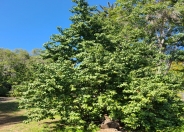
Common name: Catalina Cherry
Botanical name: Prunus ilicifolia ssp. lyonii
The Catalina cherry is an evergreen tree or shrub that grows 15'-40' high and wide. It develops showy white flowers in the spring and red fruit in the fall. It is resistant to oak root fungus. The Catalina cherry is native to California, is drought tolerant, is a beneficial insect plant, and attracts butterflies. -Cornflower Farms
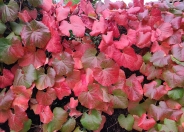
Common name: Roger's Red Wild Grape
Botanical name: Vitis x californica 'Roger's Red'
This plant is a woody deciduous vine with round large, gray green leaves.The flowers are small fragrant, white blooms and berry clusters appear in the summer. This vine has a sprawling, climbing growth habit. Leaves turn red in fall, creating a spectacular show. This plant is drought tolerant. Grapes are ornamental only. Vitis looks great on fences and overhands in the Fall when the red comes out.
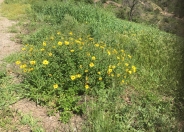
Common name: Coast Sunflower, Coast Encelia
Botanical name: Encelia californica
Encelia californica is a fast growing, woody shrub with bright green foliage and yellow daisy-type flowers that bloom from spring through summer. It can be used effectively in just about any landscape with regular or occasional pruning to maintain form. In inland situations, it requires more regular water during summer to look better. It grows to 3'-5' tall and wide. This plant attracts bees and butterflies in abundance. It does best in coastal areas from which it is native. It is a short lived plant but makes up for its shorter life with more color than most plants.
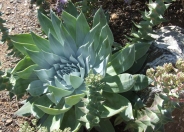
Common name: Chalk Dudleya
Botanical name: Dudleya pulverulenta
Chalk Dudleya is an attractive succulent that slowly forms 1' wide and tall rosettes. Leaves are thick and chalky looking. Basal stem may be 2" wide. During spring and summer, silvery vertical stalks bear reddish flowers. This plant does well in coastal areas needing no summer irrigation. In warmer inland areas, this plant does best with afternoon shade. It needs well draining soil. It tolerates winter and spring irrigation. Plant at an angle so water drains easily. Great plant for containers, crevices, rock gardens.
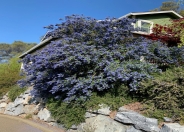
Common name: Ray Hartman California Lilac
Botanical name: Ceanothus 'Ray Hartman'
Growing vigorously as either a large shrub or small tree, the Ray Hartman has big, round, dark green leaves and medium blue, delicate flowers in 3"-5" clusters that bloom in winter and spring. It grows to 12' high and 8'-10' wide. This cultivar has good tolerance for heat; it needs occasional deep watering with good drainage. It does well in coastal as well as inland valley gardens. Deer love new foliage. Plant in full to part sun; it is not fussy about soil, growing in clay as well as sandy soil.
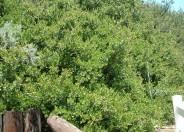
Common name: Lemonade Berry
Botanical name: Rhus integrifolia
The Lemonade Berry is an evergreen shrub that reaches 30' high. It has aromatic leaves and develops small white to pink flowers and red berries. This shrub grows best in coastal areas and is drought tolerant. The Lemonade Berry is a native to California - Cornflower Farms

Common name: Coast Sunflower, Coast Encelia
Botanical name: Encelia californica
Encelia californica is a fast growing, woody shrub with bright green foliage and yellow daisy-type flowers that bloom from spring through summer. It can be used effectively in just about any landscape with regular or occasional pruning to maintain form. In inland situations, it requires more regular water during summer to look better. It grows to 3'-5' tall and wide. This plant attracts bees and butterflies in abundance. It does best in coastal areas from which it is native. It is a short lived plant but makes up for its shorter life with more color than most plants.